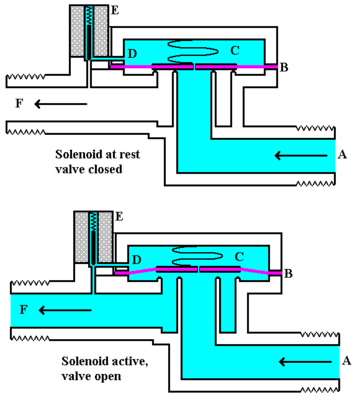A solenoid valve is an electromechanical valve for use with liquid or gas. The valve is controlled by an electric current through a solenoid: in the case of a two-port valve the flow is switched on or off; in the case of a three-port valve, the outflow is switched between the two outlet ports. Multiple solenoid valves can be placed together on a manifold.
Solenoid valves are the most frequently used control elements in fluidics. Their tasks are to shut off, release, dose, distribute or mix fluids. They are found in many application areas. Solenoids offer fast and safe switching, high reliability, long service life, good medium compatibility of the materials used, low control power and compact design.
Besides the plunger-type actuator which is used most frequently, pivoted-armature actuators and rocker actuators are also used.
A solenoid valve has two main parts: the solenoid and the valve. The solenoid converts electrical energy into mechanical energy which, in turn, opens or closes the valve mechanically. A direct acting valve has only a small flow circuit, shown within section E of this diagram (this section is mentioned below as a pilot valve). This diaphragm piloted valve multiplies this small flow by using it to control the flow through a much larger orifice.
Solenoid valves may use metal seals or rubber seals, and may also have electrical interfaces to allow for easy control. A spring may be used to hold the valve opened or closed while the valve is not activated.
The diagram to the right shows the design of a basic valve. At the top figure is the valve in its closed state. The water under pressure enters at A. B is an elastic diaphragm and above it is a weak spring pushing it down. The function of this spring is irrelevant for now as the valve would stay closed even without it. The diaphragm has a pinhole through its center which allows a very small amount of water to flow through it. This water fills the cavity C on the other side of the diaphragm so that pressure is equal on both sides of the diaphragm. While the pressure is the same on both sides of the diaphragm, the force is greater on the upper side which forces the valve shut against the incoming pressure. In the figure, the surface being acted upon is greater on the upper side which results in greater force. On the upper side the pressure is acting on the entire surface of the diaphragm while on the lower side it is only acting on the incoming pipe. This results in the valve being securely shut to any flow and, the greater the input pressure, the greater the shutting force will be.
In the previous configuration the small conduit D was blocked by a pin which is the armature of the solenoid E and which is pushed down by a spring. If the solenoid is activated by drawing the pin upwards via magnetic force from the solenoid current, the water in chamber C will flow through this conduit D to the output side of the valve. The pressure in chamber C will drop and the incoming pressure will lift the diaphragm thus opening the main valve. Water now flows directly from A to F.
When the solenoid is again deactivated and the conduit D is closed again, the spring needs very little force to push the diaphragm down again and the main valve closes. In practice there is often no separate spring, the elastomer diaphragm is moulded so that it functions as its own spring, preferring to be in the closed shape.
From this explanation it can be seen that this type of valve relies on a differential of pressure between input and output as the pressure at the input must always be greater than the pressure at the output for it to work. Should the pressure at the output, for any reason, rise above that of the input then the valve would open regardless of the state of the solenoid and pilot valve.
In some solenoid valves the solenoid acts directly on the main valve. Others use a small, complete solenoid valve, known as a pilot, to actuate a larger valve. While the second type is actually a solenoid valve combined with a pneumatically actuated valve, they are sold and packaged as a single unit referred to as a solenoid valve. Piloted valves require much less power to control, but they are noticeably slower. Piloted solenoids usually need full power at all times to open and stay open, where a direct acting solenoid may only need full power for a short period of time to open it, and only low power to hold it.
Types
Many variations are possible on the basic, one way, one solenoid valve described above:
- one or two solenoid valves;
- direct current or alternating current powered;
- different number of ways and positions;
Common uses
Solenoid valves are used in fluid power pneumatic and hydraulic systems, to control cylinders, fluid power motors or larger industrial valves. Automatic irrigation sprinkler systems also use solenoid valves with an automatic controller. Domestic washing machines and dishwashers use solenoid valves to control water entry to the machine. In the paintball industry, solenoid valves are usually referred to simply as "solenoids." They are commonly used to control a larger valve used to control the propellant (usually compressed air or CO2). In the industry, "solenoid" may also refer to an electromechanical solenoid commonly used to actuate a sear.
Besides controlling the flow of air and fluids solenoids are used in pharmacology experiments, especially for patch-clamp, which can control the application of agonist or antagonist.

0 comments:
Posting Komentar
Please Your Comment Here, If U Follow Me, i'll Follow U